We are continuing the publication of Thierry Meyssan’s book, « Before Our Very Eyes, Fake Wars and Big Lies ». In this episode, he describes how the terrorist organisation of the Muslim Brotherhood was integrated into the Pentagon. It was attached to the anti-Soviet network constituted with the ex-Nazis during the Cold War.
This article is an extract from the book Fake wars and big lies. See Contents.
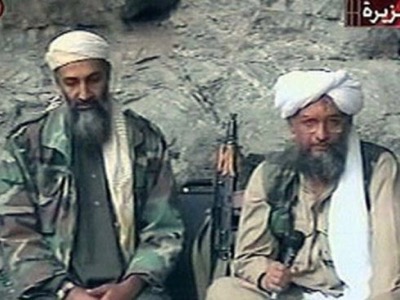
The Islamists controlled by the Pentagon
At the beginning of the 1990’s, the Pentagon decided to work with the Islamists, who had hitherto depended only on the CIA. This was operation Gladio B, by reference to the secret services of NATO in Europe (Gladio A [1]). For a decade, all the Islamist chiefs – including Osama Bin Laden and Ayman al-Zawahiri – travelled on aircraft of the US Air Force. The United Kingdom, Turkey, and Azerbaidjan participated in the operation [2]. As a direct result, the Islamists – who had so far been secret combatants – were publicly integrated into the NATO forces.
Saudi Arabia – which is both a state and the private property of the Saud family – officially became the company charged with the management of world Islamism. In 1992, the King proclaimed a Fundamental Law, which stated “The state protects Islamic Law and applies the Sharia. It imposes Good and fights Evil. It obeys the duties of Islam (…) The defence of Islamism, of society and of the Muslim homeland is the duty of every subject of the King”.
In 1993, Charles, the Prince of Wales, placed the Oxford Centre for Islamic Studies under his patronage, while the head of the Saudi secret services, Prince Turki, took over its direction.
London openly became the nerve centre of Gladio B, to the point where people spoke of “Londonistan” [3]. Under the umbrella of the Muslim World League, the Arab Muslim Brotherhood and the Pakistani Jamaat-i-Islami created a large number of cultural and cult-based associations around the mosque in Finsbury Park. This system enabled the recruitment of many kamikazes, from those who attacked the Russian school in Beslan to Richard Reid, the “shoe bomber”. Above all, Londonistan was the home for a number of medias, publishing houses, newspapers (al-Hayat and Asharq al-Awsat – both directed by the children of the present King Salman of Arabia) – and television channels (the group MBC of Prince Walid ben Talal broadcasts about twenty channels). They are not destined for the Muslim diaspora in the United Kingdom, but are broadcast in the Arab world. And since the agreement between the Islamists and Saudi Arabia had been extended to the United Kingdom, they enjoyed total freedom of action, although they were banned from interfering in domestic UK politics. The system employed several thousand people and handled gigantic quantities of money. It was to remain publicly in place until the attacks of 11 September 2001, when it became impossible for the British to continue to justify such open collaboration.
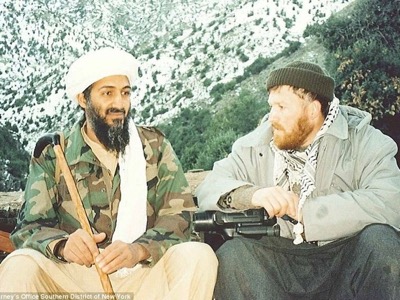
Abu Musab “The Syrian” – a survivor of the aborted coup d’état in Hama, who had become a liaison officer between Bin Laden and the Groupe Islamique Armé (GIA) of Algeria – posited the theory of “decentralised jihad” [4]. In his Call for a Global Islamic Resistance, he advanced, in Islamic terms, the well-known doctrine of the “strategy of tension”. This concerned provoking the authorities in order to spark fierce repression which would lead the people to rise against them. This tactic had already been used by the CIA/NATO Gladio networks in manipulating the European extreme left wing in the 1970’s and 1980’s (the Baader-Meinhof Complex, the Red Brigades, Action Directe). Of course, there was no question that the strategy would allow the people to prevail, and the CIA/NATO knew that it had no chance of doing so – they were never victorious anywhere – but it was intended to use the repressive reaction of the state to topple the existing élite and place its men in power.
“The Syrian” pointed to Europe – but above all, away from the United States – as the next Islamic battlefield. He fled France after the attacks of 1995. Two years later, he created the Islamic Conflict Studies Bureau in Madrid and Londonistan, on the model of Aginter Press, the Gladio cell which the CIA had created in Lisbon during the 1960’s and 1970’s. Both these structures excelled in the organisation of false-flag terrorist attacks (from those attributed to the extreme left at the Piazza Fontana, in 1969, to those blamed on Muslims in London in 2005 ).
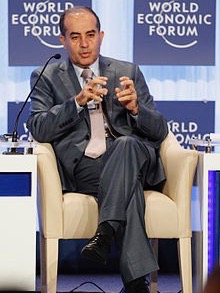
Simultaneously, the Brotherhood elaborated a vast programme of training for pro-US Arab leaders. The Libyan Mahmud Jibril El-Warfally, professor at the university of Pittsburg, taught them how to speak the language known as “politically correct”. Thus he trained Emirs and Generals from Saudi Arabia, Bahrain, Egypt, the Emirates, Jordan, Kuwait, Morocco and Tunisia (but also Singapore). Mixing the principles of public relations with studies of reports by the World Bank, the most brutal dictators were now able to expound straight-faced on their Democratic Ideal as well as their profound respect for Human Rights.
The war against Algeria spilled over into France. Jacques Chirac and his Minister for the Interior, Charles Pasqua, interrupted French support for the Muslim Brotherhood and even banned books by Yusuf al-Qaradawi (the Egyptian Brotherhood preacher). For them, it was essential to maintain French presence in the Maghreb, which the British wanted to wipe off the map. The Armed Islamic Group of Algeria (GIA) took the passengers of an Air France Algiers-Paris flight hostage (1994), exploded bombs in the Métro and various points of the French capital (1995) and planned a gigantic attack – which was foiled – during the World Football Cup in France (1998), including the crash of an aircraft onto a nuclear power plant. Each time, the suspects who managed to flee were able to find refuge in Londonistan.
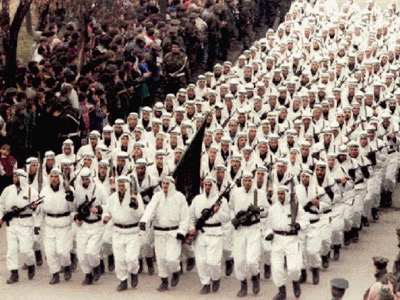
The war in Bosnia-Herzegovina began in 1992 [5]. On instructions from Washington, the Pakistani secret services (ISI), still supported financially by Saudi Arabia, sent 90,000 men to participate in the fight against the Serbs, who were supported by Moscow. Osama Bin Laden received a Bosnian diplomatic passport and became the military advisor to President Alija Izetbegović (for whom US citizen Richard Perle was diplomatic advisor, and the Frenchman Bernard-Henri Levy was Press advisor). Bin Laden formed an Arab Legion with ex-combatants from Afghanistan and supplied financing from the Muslim World League. Either by a sense of confessional solidarity or in competition with Saudi Arabia, the Islamic Republic of Iran also came to the help of the Bosnian Muslims. With the Pentagon’s blessing, it sent several hundred Guardians of the Revolution and a unit of the Lebanese Hezbollah. Above all, it delivered the main weapons used by the Bosnian army. The Russian secret services, who penetrated Bin Laden’s camp, found out that the Arab Legion’s entire bureaucracy was written in English, and that the Legion was taking its orders directly from NATO. After the war, a special International Tribunal was created. It launched criminal proceedings against a number of combatants for war crimes, but not one was a member of the Arab Legion.
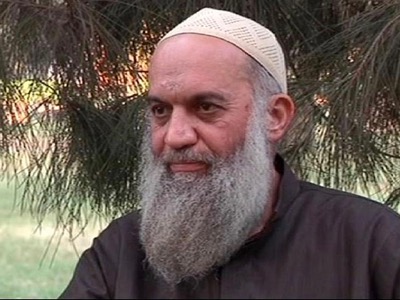
After three years of quiet, the war between Muslims and Orthodox Christians started up again in ex-Yugoslavia, this time in Kosovo. The Kosovo Liberation Army (UÇK) was composed of mafia-style groups trained in combat by the German Special Forces (KSK) at the Turkish base of Incirlik. The Albanians and the Muslim Yugoslavs shared a Naqshbandi culture. Hakan Fidan, the future head of the Turkish secret services, was a liaison officer between NATO and Turkey. The veterans of the Arab Legion joined the UÇK, of which one brigade was commanded by a brother of Ayman al-Zawahiri. He systematically destroyed Orthodox churches and monasteries and forced the Christians to flee.
In 1995, reviving the tradition of political assassination, Osama Bin Laden attempted to eliminate Egyptian President Hosni Mubarak. He did the same a year later with the Libyan Guide, Muammar Gaddafi. This second attack was paid for with £100,000 by the British secret services, who sought to punish Libya for supporting the Irish resistance [6]. However, the operation failed. Several Libyan officers fled to the United Kingdom. Among them was, Ramadan Abidi, whose son, many years later, was to be tasked, still by the British secret services, with carrying out a terrorist attack in Manchester. Libya transmitted its evidence to Interpol and issued the first international arrest warrant for the person of Osama Bin Laden, who still maintained a public relations bureau in Londonistan.
In 1998, the Arab Commission for Human Rights was founded in Paris. It was financed by the NED. Its President was the Tunisian Moncef Marzouki, and its spokesman was the Syrian Haytham Manna. Its objective was to defend members of the Muslim Brotherhood who had been arrested in different Arab countries for their terrorist activities. Marzouki was a left-wing doctor who had been working with the Brotherhood for a long time. Manna was a writer who managed the financial investments of Hassan el-Turabi and the Sudanese Brothers in Europe. When Manna retired, his partner stayed on as the Director of the association. Manna was replaced by the Algerian Rachid Mesli, a lawyer. He was incidentally the lawyer for Abassi Madani and the Algerian Brotherhood.
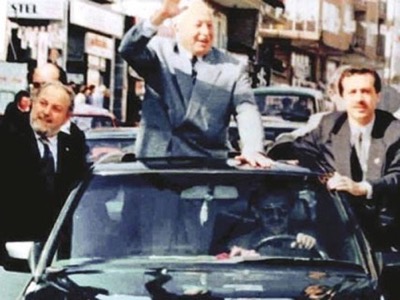
In 1999 (after the war in Kosovo and the power grab by the Islamists in Grozny), Zbigniew Brzeziński, with a cohort of neo-conservatives, founded the American Committee for Peace in Chechnya. While the first war in Chechnya had been an internal Russian affair in which a few Islamists had taken part, the second war was aimed at the creation of the Islamic Emirate of Ichkeria. Brzeziński, who had been preparing this operation for several years, attempted to reproduce the Afghan experience. The Chechen jihadists, like Shamil Basayev, had not been trained in Sudan by Bin Laden, but in Afghanistan by the Taliban. Throughout the whole war, they benefited from the “humanitarian” support offered by Necmettin Erbakan and Recep Tayyip Erdoğan’s Turkish Millî Görüş, and the “IHH – Human Rights and Freedoms”. This Turkish association had been created in Germany under the name of Internationale Humanitäre Hilfe (IHH). Thereafter, they organised several major operations – notably against the Moscow Theatre (in 2002 – 170 dead, 700 wounded); against a school in Beslan (in 2004 – 385 dead, 783 wounded); and against the town of Nalchik (in 2005 – 128 dead, 115 wounded). After the massacre in Beslan and the death of jihadist leader Shamil Basayev, Millî Görüş and the IHH organised an extravagant funeral service at the Fatih mosque in Istanbul – the body was not present, but tens of thousands of militants attended the ceremony.
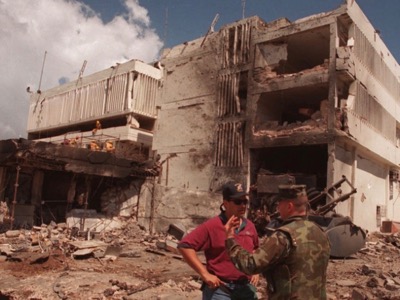
During this period, three important terrorist attacks were attributed to al-Qaeda. But however important these operations may have been, they represented an abasement for the Islamists, who were an integral part of NATO, but at the same time found themselves relegated to the level of anti-American terrorists.
– In 1996, a truck bomb exploded in front of an eight-story tower in Khobar, Saudi Arabia, killing 19 US soldiers. First attributed to al-Qaeda, responsibility for the attack was next pinned on Iran, and then finally, on no one at all.
– In 1998, two bombs exploded in front of the US embassies in Nairobi, Kenya, and Dar-es-Salam, Tanzania, killing 298 Africans – but no US citizens – and wounding more than 4,500. These attacks were claimed by a mysterious “Islamic Army for the Liberation of Holy Places”. According to US authorities, the attacks had been committed by members of the Egyptian Islamic Jihad in response to the extradition of four of their members. And yet the same authorities accused Osama Bin Laden of being the instigator of the attacks, and the FBI issued – finally – an international arrest warrant for him.
– In 2000, a suicide boat exploded against the hull of the destroyer USS Cole, harboured in Aden, Yemen. The attack was claimed by al-Qaeda in the Arab Gulf Peninsula, but a US tribunal blamed Sudan.
These attacks occurred while the collaboration between Washington and the Islamists was on-going. Osama Bin Laden therefore held onto his bureau in Londonistan until 1999. Situated in the neighbourhood of Wembley, the Advice and Reformation Committee (ARC), served to disseminate Bin Laden’s declarations and also to cover the logistical activities of al-Qaeda, including matters of recruitment, payments, and the acquisition of equipment. Among his collaborators in London, we find the Saudi Khalid al-Fawwaz and the Egyptians Adel Abdel Bary (father of the suspected Jihadi John) and Ibrahim Eidarous, three men who were the objects of international arrest warrants, but had nonetheless received political asylum in the United Kingdom. It was in perfect legality in London that Bin Laden’s bureau published, in February 1998, his famous Appeal for a jihad against Jews and Crusaders. Seriously ill with kidney disease, Bin Laden was hospitalised, in August 2001, at the American Hospital in Dubai. A head of one of the Gulf states assured me that he had visited him in his room, where security was provided by the CIA.
The fusion of the two “Gladio” networks and the preparation of Daesh
Following the same logic, the Bush administration blamed the Islamists for the gigantic attacks which occurred on 11 September 2001 in the United States. The official version prevailed, although it contains innumerable incoherences. The Justice Secretary assured that the planes were hijacked by the Islamists, despite the fact that, according to the airline companies themselves, none of the suspects were on board. The Department of Defense published a video in which Bin Laden claimed responsibility for the attacks, despite the fact that he had publicly denied it, and that experts in facial and vocal recognition affirmed that the man in the video was not Bin Laden. In any case, these events served as the pretext for Washington and London to launch the “Endless War” on terrorism and attack their ex-allies, the Taliban in Afghanistan, and Saddam Hussein’s Iraq.
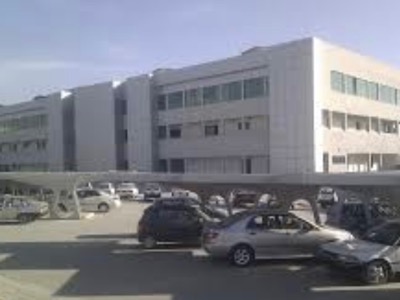
Although Osama Bin Laden suffered from chronic kidney disease, he died on 15 December 2001 from the consequences of Marfan Syndrome. A representative of MI6 was present at his funeral in Afghanistan. For a while, several more or less life-like body doubles kept his image alive, one of whom was himself assassinated in 2005 by Omar Sheikh, according to Pakistani Prime Minister Benazir Bhutto.
In August 2002, MI6 organised a conference in London for the Muslim Brotherhood on the theme “Syria for All”. The speakers developed the idea that Syria was oppressed by the Alawite cult, and that only the Muslim Brotherhood could offer true equality.
After Sayyed Qutb and Abu Musab “the Syrian”, the Islamists found a new strategist, Abu Bakr Naji. In 2004, this character, who seems never to have existed, published a work on the Internet, “The Management of Savagery, a chaos theory” [7]. Although certain authors believed they could recognise the style of an Egyptian writer, it seemed that the book had been written in English, sprinkled with superfluous Qu’ranic quotes, and then translated into Arabic. The “Savagery” in the book’s title did not refer to a recourse to terrorism, but a return to the state of nature before civilisation created the state. It was about dragging Humanity back to the time when “Man is a wolf for Man”. The strategy of chaos is explained in three phases:
– First, demoralise and exhaust the state by attacking its least-protected flanks. Choose secondary targets, often without strategic value, but easy to destroy and disperse. The point is to give the impression of a general uprising, a revolution.
– Second, when the state has withdrawn from the suburbs and the countryside, conquer certain zones and administer them. It will be necessary to rely on the Sharia to signal the passage to a new form of state. During this period, build alliances with all those who are opposed to Power – they must be given weapons. Then the war will become a war of position.
– Third, proclaim the Islamic state.
This treatise draws on contemporary military science. It places much importance on psychological operations, notably the use of spectacular violence. In practise, this strategy has nothing to do with revolution, but with the conquest of a country by exterior powers, because it supposes a massive investment. As always in subversive literature, the most interesting aspects are those which are not clearly stated, or quoted only incidentally.
– The preparation of populations to gladly welcome the jihadists supposes the previous construction of a network of mosques and social works, as was done in Algeria before the “civil” war.
– The primary military operations require arms, which must be imported beforehand. Above all, after the campaign, the jihadists will have no possibility of acquiring weapons, and even less ammunition. They will therefore need to be supplied from outside.
– The administration of the occupied zones supposes the participation of senior executives who have been trained in advance, like those of regular armies tasked with “rebuilding states”.
– Finally, the war of position supposes the construction of enormous infrastructures which will require a great deal of equipment, materials, engineers and architects.
By invoking this treatise the Islamists revealed their intent to continue playing a military role on behalf of external forces, but this time on a massive scale.
In 2006, the British asked Emir Hamad of Qatar to place his pan-Arab TV channel, al-Jazeera, at the service of the Muslim Brotherhood [8]. The Libyan Mahmud Jibril, who had trained the royal family to speak in democratic language, was tasked with carefully introducing the Brotherhood into the channel, and creating channels in foreign languages (English, and then later, Bosnian and Turkish), as well as a channel destined for children. The preacher Yusuf al-Qaradawi became the “religious advisor” for al-Jazeera. Of course, the channel broadcast and validated the audio and video recordings of the various “Osama Bin Ladens”.
During the same period, US troops in Iraq were faced with a growing uprising. After having been utterly demoralised by the suddenness and brutality of the invasion (the “Shock and Awe technique”), the Iraqis were beginning to organise their resistance. John Negroponte, US ambassador in Baghdad, and then Director of National Intelligence, proposed to overcome the resistance fighters by turning their anger against themselves, and transforming the resistance to the occupation into a civil war. An expert in secret operations, he had notably participated in Operation Phoenix in Vietnam, then organised a civil war in Salvador and the Iran-Contras operation in Nicaragua, and guided the collapse of the Free and Sovereign State of Chiapas in Mexico. Negroponte called on one of the men he had worked with in Salvador, Colonel James Steele. He entrusted him with creating Iraqi Shiite militias against the Sunnis, and Sunni militias against the Shiites. For the Sunni militia, Steele used the Islamists. From al-Qaeda in Iraq, he armed a tribal coalition, the Islamic Emirate in Iraq (future Daesh), under cover of the Special Police (“the Wolf Brigade”). In order to terrify the victims and their families, he trained the Emirate in torture, according to the methods of the School of the Americas and the Political Warfare Cadres Academy in Taiwan, where he taught.
Within a few months, a new terror came crashing down on the Iraqis and divided them according to their religion. Thereafter, when General David Petraeus took command of the US troops in-country, he designated Colonel James H. Coffman to work with Steele and provide him with reports on the operation, while Brett H. McGurk advised the President directly. The principal heads of the Islamic Emirate were recruited at the detention center at Camp Bucca, but were conditioned at Abu Ghraib prison, according to the “brainwashing” techniques of professors Albert D. Biderman and Martin Seligman [9]. The whole programme was supervised from Washington by the Secretary for Defense Donald Rumsfeld, who was Steele’s direct superior.
In 2007, Washington informed the Brotherhood that it intended to overthrow the secular régimes in the Greater Middle East, including those of the allied states, and that it should prepare to exercise power. The CIA organised the alliances between the Brotherhood and the secular parties or personalities from all the states in the region. At the same time, it connected the two “Gladio” branches by reinforcing the ties between the Western Nazi groups and the Oriental Islamist groups.
These alliances were sometimes unstable – for example during the “National Conference of the Libyan Opposition”, in London, the Brotherhood was only able to bring together the Islamic group fighting in Libya (al-Qaeda in Libya) and the Wahhabi Senussi Brotherhood. The platform of the programme involved re-establishing the monarchy and making Islam the state religion. More convincing was the constitution of the National Salvation Front, in Berlin, which officialised the cooperation of the Brotherhood and ex-Syrian vice President Abdel Halim Khaddam.
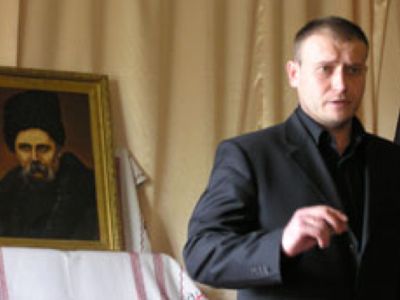
On 8 May 2007, in Ternopol (West Ukraine), a number of small Nazi and Islamist groups created an anti-Imperialist Front in order to fight Russia. Organisations from Lithuania, Poland, Ukraine and Russia participated, including the Islamist separatists from Crimea, Adygea, Dagestan, Ingushetia, Kabardino-Balkaria, Karachay-Cherkessia, Ossetia, and Chechnya. Since he could not travel there because of international sanctions against him, Doku Umarov – who had abolished the Republic of Chechnya and proclaimed the Islamic Emirate of Ichkeria – had his contribution read on his behalf. The Front was presided over by Dmytro Yarosh, who, during the coup d’état in Kiev, in February 2014, was to become Assistant Secretary of the National Security Council of Ukraine.
In Lebanon, May-June 2007, the national army began the siege of the Palestinian camp of Nahr al-Bared, after members of Fatah el-Islam had taken refuge there. The combats lasted for 32 days and cost the lives of 76 soldiers, about thirty of whom were decapitated.
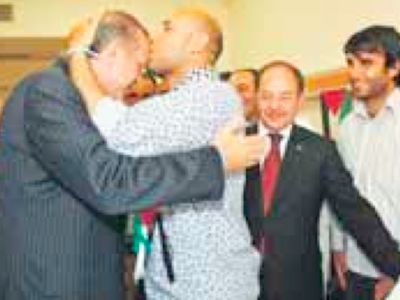
In 2010, the Brotherhood organised the Gaza Freedom Flotilla, via the IHH. Officially, it was intended to brave the Israeli embargo and bring humanitarian aid to the citizens of Gaza [10]. In reality, the main ship in this flotilla changed its flag of convenience during the crossing, and continued under Turkish colours. Numerous spies mingled with the non-violent militants taking part in the expedition, including the Irish CIA agent, Mahdi al-Harati. Falling into the trap laid for him by the United States, Israeli Prime Minister Benjamin Netanyahu ordered the assault of the ships in international waters. The whole world condemned this act of piracy, under the mocking eyes of the White House. Israel, which had supplied weapons to the jihadists in Afghanistan, and supported the creation of Hamas against Yasser Arafat’s PLO, turned against the Islamists in 2008 and bombed them, along with the population of Gaza. In this way, Netanyahu paid for Operation “Cast Lead,” which it had led with Saudi Arabia against the advice of the White House. Finally, the passengers from the Flotilla were freed by Israel. The Turkish Press then showed Prime Minister Recep Tayyip Erdoğan visiting Mahdi al-Harati in hospital.
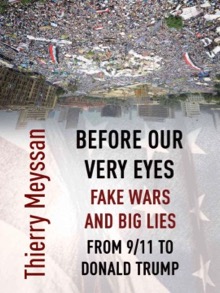
This book is available in English langage.
[1] NATO’s secret armies: operation Gladio and terrorism in Western Europe, Daniele Ganser, Foreword by Dr. John Prados, Frank Cass/Routledge (2005).
[2] Classified Woman: The Sibel Edmonds Story : A Memoir, Sibel Edmonds (2012).
[3] Londonistan, Melanie Phillips, Encounter Books (2006).
[4] Architect of Global Jihad : The Life of Al Qaeda Strategist Abu Mus’ab Al-Suri, Brynjar Lia, Columbia University Press, 2009.
[5] Wie der Dschihad nach Europa kam, Jürgen Elsässer, NP Verlag (2005); Intelligence and the war in Bosnia 1992-1995: The role of the intelligence and security services, Nederlands Instituut voor Oologsdocumentatie (2010). Al-Qaida’s Jihad in Europe: The Afghan-Bosnian Network, Evan Kohlmann, Berg (2011).
[6] “David Shayler: “I quit the British secret service when the MI6 decided to fund Osama bin Laden’s partners””, Voltaire Network, 24 November 2005.
[7] The Management of Savagery: The Most Critical Stage Through Which the Umma Will Pass, Abu Bakr Naji, Harvard University (2006).
[8] “Wadah Khanfar, Al-Jazeera and the triumph of televised propaganda”, by Thierry Meyssan, Voltaire Network, 26 September 2011.
[9] “The secret behind Guantánamo”, by Thierry Meyssan, Оdnako (Russia) , Voltaire Network, 20 May 2010.
[10] “Freedom Flotilla: The detail that escaped Netanyahu”, by Thierry Meyssan, Voltaire Network, 8 June 2010.

 Articles by this author
Articles by this author Send a message
Send a message















Stay In Touch
Follow us on social networks
Subscribe to weekly newsletter